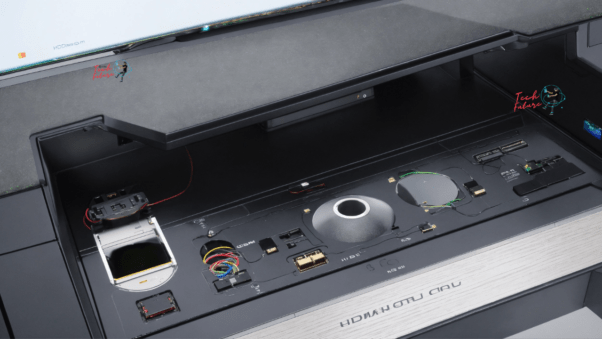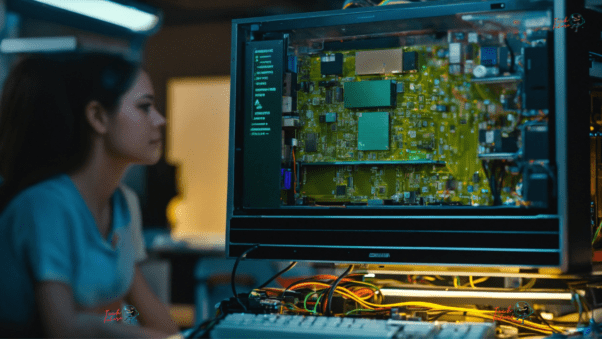In the dynamic field of storage technology, The decision between SATA (Serial ATA) and SAS (Serial Attached SCSI) is a critical factor that profoundly shapes system performance, reliability, and scalability. It’s like choosing the architectural foundation of your digital landscape, a choice that resonates with all data transactions and operations.
SATA can be compared to a reliable sedan in a maintenance fleet – economical and efficient for routine tasks. Meanwhile, the SAS stands out as a powerful SUV built for tough jobs, offering maximum performance even in the toughest conditions. Recognizing the nuances between SATA and SAS isn’t just about technical features.
It’s about understanding their unique role in the digital domain. Whether you’re optimizing day-to-day operations or preparing for data-driven challenges, this decision becomes a strategic move in the ever-evolving data storage landscape.
Introduction SATA and SAS
Definition of SATA and SAS
SATA (Serial ATA) and SAS (Serial Attached SCSI) are two different storage interfaces commonly used in computing systems. SATA is a widely accepted standard designed to connect hard drives and solid-state drives to motherboards and storage controllers. It is known for its simplicity, cost-effectiveness, and compatibility with consumer-grade applications. SATA is often used in personal computers, laptops, and other devices where performance requirements are moderate.
On the other hand, SAS is a more advanced and enterprise-oriented interface. Designed for high-performance and mission-critical applications, SAS offers faster data transfer rates and greater reliability than SATA. It is commonly found in server environments and storage systems where speed, scalability, and data integrity are paramount. SAS supports a large number of connected devices and is known for its durability, making it suitable for business and professional use cases.
The importance of choosing the right storage interface
Choosing the right storage interface is important because it directly affects critical aspects such as data transfer speed, reliability, and overall system performance. The chosen interface becomes the bridge between the storage devices and the rest of the system, shaping how efficiently data is accessed, processed, and stored.
An informed decision when choosing a storage interface is essential to ensure that the storage solution is tailored to the unique needs of the user or organization. The impact goes beyond just technical considerations. This affects the day-to-day functionality and long-term reliability of the system.
Whether improving the speed of data-intensive tasks or prioritizing reliability in mission-critical applications, the storage interface is a fundamental component that can make or break the performance of the entire system. Therefore, the importance of thoughtful and informed selection cannot be overstated as it lays the foundation for a storage solution that seamlessly meets the specific needs and goals of a user or organization.
SATA (Serial ATA)
Overview
Serial ATA, often referred to as SATA, is a widely used interface used to connect storage devices. It is commonly found in consumer-grade computers, providing a balance between performance and cost-effectiveness. This makes it a popular choice for a variety of applications where moderate performance meets budget considerations.
Performance characteristics
The performance characteristics of the SATA interface generally have a lower data transfer rate than SAS. This feature makes SATA suitable for general-purpose computing tasks, including activities such as home use and standard office applications. While SATA may not match the high-speed demands of an enterprise environment, its balance of performance and cost-effectiveness make it a practical choice for everyday computing needs.
Use cases
SATA is commonly used in desktop computers, laptops, and external hard drives. Its widespread use in these devices is due to its affordability and satisfactory performance, making it ideal for meeting users’ daily computing needs. Whether integrated into desktop systems, powering laptops, or supporting external storage solutions, SATA’s combination of cost-effectiveness and reliable performance make it a common choice in a variety of consumer-oriented computing environments.
Advantages and Disadvantages
- Pros: Economical, widely compatible, suitable for basic applications.
- Disadvantages: Limited data transfer speed, and less powerful error-checking mechanisms.
SAS (serial attached SCSI)

Overview
Serial Attached SCSI, or SAS, is like a high-performance teacher in the orchestration of storage interfaces. This is not your everyday player. It is designed for demanding solos in an enterprise environment where storage requirements are complex and critical for a single chord.
Think of SAS as a virtuoso in the memory world, perfectly positioned to deliver exceptional performance and unwavering reliability. In the tumultuous backstage of enterprise data management, SAS stands on stage, ensuring that every note of performance hits the right pitch and every beat of reliability is solid.
Performance characteristics
In the area of performance characteristics, SAS interfaces outperform SATA by offering higher data transfer rates. This makes them the choice for applications that demand fast and constant access to significant volumes of data. Whether managing large databases or managing data-intensive tasks, SAS leads the way and provides a high-speed highway for seamless and efficient data transactions.
Use cases
In practical applications, SAS takes center stage in servers, data centers, and various enterprise-class systems. Its prevalence in this environment is attributed to its high performance and advanced features, which make it an excellent choice for complex tasks. From orchestrating complex database management to powering high-performance computing engines, SAS proves its worth by providing the power and capabilities needed to meet the demanding demands of enterprise-class operations.
Advantages and Disadvantages
- Pros: high data transfer rate, advanced error detection, and correction, ideal for enterprise environments.
- Disadvantages: Higher cost than SATA, which may be excessive for standard user needs.
Speed and Bandwidth
SATA speed limitations
The SATA interface has a speed limit, particularly shown in the latest version, SATA III, which exceeds the theoretical maximum data transfer speed of 6 Gbit/s. This limitation creates a potential bottleneck, especially in scenarios where fast data access is essential. While SATA serves a variety of applications well, its speed limitations may cause you to consider alternatives in situations that require higher bandwidth capabilities.
SAS high-speed capabilities.
In contrast, SAS interfaces boast high-speed capabilities, with the latest versions achieving data transfer rates of 12 Gb/s or more. This high-speed limit makes SAS the preferred choice for applications where speed is a critical factor. Whether managing large data sets in an enterprise environment or performing high-performance computing tasks, SAS has high-speed data transfer capabilities that deliver the speed required for demanding and data-intensive operations.
Effect on the data transfer rate
The decision between SATA and SAS should be tailored to the speed needs of specific applications. When it comes to tasks that require fast data access, SAS emerges as the top choice. Understanding the impact on data transfer speed is critical, and choosing SAS ensures that the storage solution meets the need for fast data transactions in scenarios where speed is critical.
Reliability and Redundancy
Error-checking mechanisms in SATA
In terms of error-checking mechanisms, SATA uses basic measures that offer a baseline of data integrity. However, compared to the more advanced error-checking capabilities of SAS, SATA lacks a certain level of sophistication. Consequently, SATA is considered more suitable for applications where the data is less critical, as its error-checking mechanism may have limitations in handling requests from more critical scenarios.
Advanced SAS error detection and correction
SAS sets a high standard for data reliability by incorporating advanced error detection and correction functions. In enterprise environments where uncompromised data integrity is a non-negotiable requirement, SAS is the focus. Its sophisticated fault-handling capabilities help maintain a robust and reliable data infrastructure that fully meets the stringent requirements of critical and mission-critical applications.
Value in data-intensive applications
In data-intensive applications, especially those that process mission-critical data such as financial transactions or scientific simulations, SAS’s advanced error-checking capabilities become indispensable. The value lies in SAS’ ability to provide increased levels of data integrity and reliability, ensuring that critical processes dependent on accurate and error-free data can be implemented without compromise.
In situations where accuracy is paramount, SAS stands out as a critical component that provides a solid foundation for applications where the stakes are high and data accuracy is non-negotiable.
Graph to illustrate the differences between SATA and SAS
| Aspect | SATA | SAS |
|---|---|---|
| Primary Purpose | Mainly used for consumer-grade devices | Primarily designed for enterprise environments |
| Performance | Generally offers lower data transfer rates | Provides higher data transfer rates |
| Reliability | More suitable for standard desktop usage | Designed for mission-critical and server applications |
| Compatibility | Widely compatible with various devices | Commonly used in high-end servers and enterprise storage systems |
| Hot Swapping | Typically not designed for hot-swapping | Supports hot-swapping for increased flexibility |
| Usage | Commonly found in personal computers and consumer electronics | Preferred in professional and enterprise settings |
| Cable Length | Limited cable length (up to 1 meter) | Supports longer cable lengths (up to 10 meters) |
| Cost | Generally more cost-effective | Tends to be more expensive due to advanced features |
Expandability
SATA expandability limitations
SATA interfaces generally exhibit less scalability than SAS. This limitation may affect users or organizations planning future expansions or upgrades. SATA’s limited scalability can create challenges when targeting increased storage capacity or improved performance in developing computing environments. This is a factor for future growth and to ensure that the storage infrastructure can seamlessly expand with the evolving needs of users or organizations.
Scalability benefits of SAS
SAS has significant scalability advantages, allowing a large number of devices to be connected to a single controller. This improved scalability is particularly beneficial in enterprise situations where data requirements are increasing. SAS’s ability to accommodate large amounts of devices makes it the preferred choice for expanding storage needs in dynamic and growing computing environments in the enterprise sector.
Considerations for Future Expansion
When considering future expansion and scalability, choosing SAS becomes a strategic decision to ensure that the storage infrastructure can deftly meet the growing demands of data-intensive applications. SAS’s inherent scalability features make it a forward-thinking choice, providing the flexibility needed to handle growing data needs over time.
This consideration becomes critical for organizations and customers looking to future-proof their storage solutions and ensure a smooth and efficient transition as their computing needs evolve.
Cost Factors
Affordability of SATA
SATA has a significant advantage in terms of availability. This makes it an attractive option, especially for users on a tight budget or those with standard computing needs. SATA’s affordability makes it a practical and affordable solution that provides reliable storage without breaking the bank. Whether for personal computing or day-to-day work demands, SATA’s affordability makes it a viable choice for those who are budget-conscious.
SAS’ superior value and value proposition
SAS interface is more expensive than SATA. However, this increased cost is justified by the high performance, reliability, and advanced features that SAS brings to the table. While the initial investment may be high, SAS’s value proposition lies in its ability to deliver high performance and unwavering reliability, making it a worthwhile choice for applications where data integrity and speed are critical.
Skills are the most important. SAS’s higher price is an investment in the enhanced capabilities and robustness it offers, positioning it as a valuable solution for mission-critical and performance-intensive scenarios.
Expenditure according to performance requirements
The decision between SATA and SAS depends on the delicate balance of cost versus the performance needs of the intended applications. Known for its budget-friendly nature, SATA is a practical choice for those with budget or standard computing needs.
On the other hand, SAS justifies its higher cost by delivering higher performance, making it the preferred option in scenarios where application requests require better capacity and reliability, which may involve additional investment. Is. It is a strategic choice that ensures that the chosen storage solution perfectly meets the performance requirements within the current budget constraints.
Compatibility

Device compatibility with SATA
SATA has wide compatibility, which creates a scenario where it is easy to find devices that support this interface. This was instrumental in establishing the widespread popularity of SATA, especially in consumer-grade electronics. Whether in laptops, desktops, or external storage devices, the ease of finding SATA-compatible devices increases its appeal as a widely accepted and versatile storage interface in consumer electronics.
SAS Compatibility and Interoperability
SAS devices are less common in consumer electronics, and more used in enterprise environments. In the field of storage solutions, compatibility, and interoperability issues become an important factor in guaranteeing smooth integration with existing systems. Although SAS may be less common in everyday consumer devices, its widespread use in enterprise settings underscores its importance for applications that require performance, reliability, and seamless interoperability with modern systems. is important.
Choosing the right interface for specific devices
When it comes to choosing the right interface for specific devices, SATA often appears as the default choice for personal devices such as laptops or desktops. Its wide compatibility makes it a practical and versatile option for everyday computing needs. However, when working with enterprise-level systems, SAS draws attention as the preferred option.
The performance and reliability that SAS brings to the table make it suitable for the demanding requirements of enterprise environments where high-level capabilities are necessary for continuous operations. The choice between SATA and SAS is therefore influenced by the specific needs of the devices and the level of performance required for their respective applications.
RAID Support
SATA RAID Capabilities
SATA interfaces support RAID configuration, which gives users the ability to improve data protection and set redundant storage options. This allows for increased reliability and guarantees against potential data loss. However, it is important to note that SATA’s RAID capabilities are not as robust as those offered by SAS. While suitable for a variety of applications, particularly in consumer-level scenarios, SAS offers advanced RAID features and high levels of performance in more demanding enterprise environments.
SAS’s robust RAID support
SAS is known for its robust RAID support, offering customers advanced options for data redundancy, fault tolerance, and performance optimization. This feature becomes especially important in enterprise environments dealing with critical data. SAS’s comprehensive RAID capabilities help create highly flexible and efficient storage configurations that ensure data safety and availability even in the event of hardware failure or other potential problems. This makes SAS the preferred choice in scenarios where the highest level of data protection and system reliability are paramount.
Ensuring data security and fault tolerance
When considering a RAID setup, SAS’ superior RAID support emerges as a deciding factor, especially in applications where data protection and fault tolerance are paramount. SAS’s advanced RAID capabilities play an important role in creating solid storage configurations that not only enhance data security but also ensure uninterrupted system operation in the event of a potential failure or failure. This becomes an important consideration for environments where data reliability and security are non-negotiable, making SAS the preferred choice for applications with data rigidity and fault tolerance requirements. Is.
Application-specific considerations
Applications best suited for SATA
SATA is particularly suited for standard computing needs, such as web browsing, document editing, and multimedia consumption. Its affordability adds to its appeal, making it a great choice for users who prefer a budget solution without compromising on basic features. Whether in laptops, desktops, or external storage, SATA stands out as a practical and economical option for everyday computing tasks.
Ideal scenarios for using SAS
SAS excels in scenarios that demand high-performance storage, making it an ideal choice for applications such as data analytics, virtualization, and enterprise-class databases. Its advanced features and capabilities position it as a solution for mission-critical business operations where speed, reliability, and data integrity are impossible.
Whether handling complex data analytics tasks, supporting virtualized environments, or managing large-scale databases, SAS stands out as a robust and reliable storage interface that delivers superior performance in mission-critical applications. does.
Storage solutions tailored to specific needs
The decision between SATA and SAS revolves around tailoring the storage solution to meet the specific needs of target applications. This tailoring process ensures that the selected interface meets the unique system requirements, provides optimal performance, and ensures value for investment. Whether prioritizing cost efficiency for standard computing tasks or seeking advanced features for high-performance applications, a strategic choice between SATA and SAS allows customers to build storage solutions that meet their needs. And be consistent with the goals.
Future Trends
Advances in SATA technology
SATA technology continues to evolve, with constant development on improving data transfer speeds and overall performance. It is important to be aware of these ongoing developments for users looking to take advantage of SATA’s emerging benefits in the future. As technology advances, users can expect better capabilities and better performance, making it important to stay updated to make the most informed decisions for their storage needs.
Developments in SAS
With a strong focus on pushing the limits of data transfer rates and introducing innovative features, SAS technology continues to advance. These developments are important for individuals and organizations investing in SAS storage solutions to be aware of. With the latest developments, customers can position themselves with the latest capabilities, ensuring that their SAS-based storage infrastructure is among the best in performance and reliability in the evolving landscape of data storage technologies. Stay ahead.
Predictions for the future of storage interfaces
Storage interface technologies are expected to converge in the future, with SATA and SAS playing an integral role in a variety of applications. Accurately predicting the pace of these events requires close monitoring of industry trends and technological developments.
As developments continue, we may see a seamless integration of both SATA and SAS features to meet a wider range of storage needs. Staying abreast of emerging trends and developments will be critical to understanding how storage interfaces are evolving and adapting storage solutions to meet the changing demands of the digital landscape.
Case Studies

Real-world examples of SATA implementations
Home Accounting:
SATA is widely used in home computers for everyday tasks such as web browsing, document editing, and multimedia consumption. Its affordability and compatibility make it a popular choice for personal computing needs.
Small Business Servers:
Many small businesses use SATA in their server configurations for file storage, email, and basic database applications. Its cost-effectiveness fits within the budget constraints of small businesses and provides reliable storage capabilities.
External hard drives:
SATA is commonly used for backup and additional storage on external hard drives. Its compatibility and ease of use make it an affordable option for users looking to expand their storage capacity.
Game consoles:
SATA is often used in gaming consoles to store game data and applications. Its balance of performance and cost efficiency meets the needs of gaming systems.
Media Servers:
In-home or small-scale media server setups, SATA drives are often used to store and stream multimedia content. SATA’s moderate performance meets the demands of media streaming applications.
These examples highlight SATA’s versatility in a variety of environments, demonstrating its effectiveness in meeting the diverse storage needs of both individuals and organizations.
Success Stories Using SAS Technology
Financial Institutions:
Many financial institutions where data integrity and speed are important to use SAS technology in their storage infrastructure. This ensures fast and reliable access to financial data, which is critical for timely decision-making and regulatory compliance.
Health Care System:
Hospitals and healthcare organizations use SAS to store and manage large volumes of patient data, medical records, and image files. SAS’s high-performance capabilities facilitate rapid retrieval of information critical to patient care.
E-Commerce Platforms:
Large-scale e-commerce platforms that handle large amounts of transaction data rely on SAS technology for their storage solutions. Advanced SAS features support the smooth processing of online transactions and ensures customer data security.
Cloud Service Providers:
SAS technology is often integral to the storage architecture of cloud service providers. SAS’s scalability, reliability, and high-speed capabilities are critical to meeting the diverse storage needs of cloud-based applications and services.
Scientific Research Centers:
SAS is used in research environments that deal with data-intensive tasks such as scientific simulations and data analysis. Its advanced features facilitate the high-performance computing required in scientific research.
These success stories highlight how SAS technology excels in enterprise-class applications, demonstrating its value in environments where speed, reliability, and advanced storage capabilities are paramount.
Conclusion
In the end, the decision between SATA and SAS depends on careful consideration of key differences and specific requirements. SATA, with its affordability and compatibility, is an excellent choice for budget-conscious users and standard computing needs. On the other hand, SAS is emerging as a preferred option for enterprise environments, in high-performance scenarios where reliability is non-negotiable.
The choice is not uniform but is made according to factors such as speed requirements, reliability, scalability, and budget considerations. Balancing these considerations ensures an informed decision that matches the intended use, highlighting SATA’s adaptability and SAS’ ability to meet a variety of storage needs.
Frequently Asked Questions
What is the main difference between SATA and SAS?
The main difference is in the performance and focus of the application. SATA is cost-effective for general use, while SAS is best in high-performance and enterprise environments.
Can I use SATA and SAS drives together in a system?
In some cases, this is possible, but compatibility issues may arise. For best performance, it is recommended to use a sequential interface.
Which is better for home use, SATA or SAS?
SATA is more useful for home use, offering a balance between performance and affordability suitable for everyday computing tasks.
How do SATA and SAS affect gaming performance?
SATA is usually enough for games. The benefits of SAS become more apparent in data-intensive applications than in gaming scenarios.
Are there compatibility issues when upgrading from SATA to SAS?
Differences in interface and performance characteristics may cause compatibility issues. It is advisable to consult the manufacturers and ensure compatibility before upgrading.

